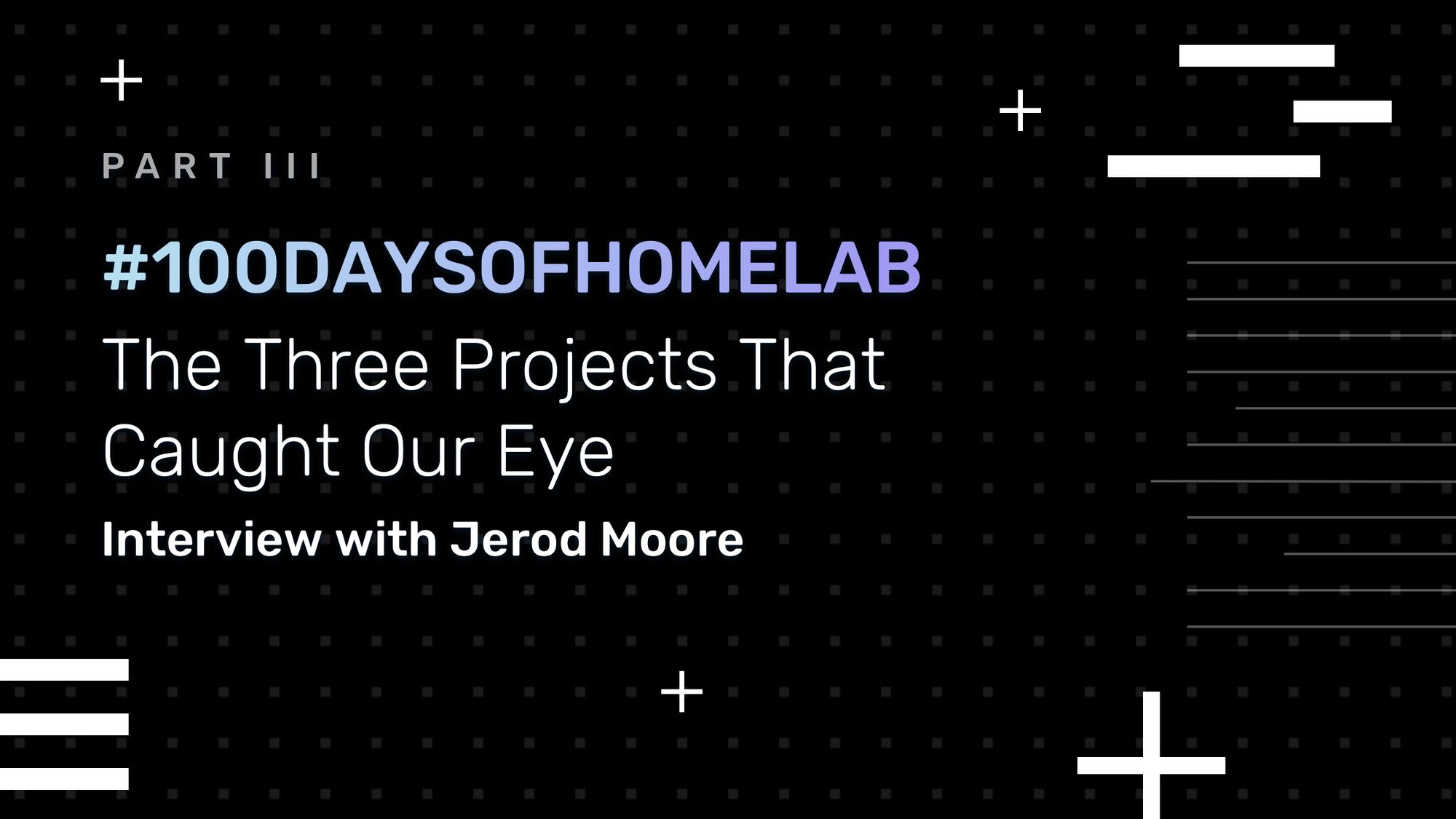#100DaysOfHomeLab Wrap Up Part III: The Three Projects That Caught Our Eye
Interview with Jerod Moore

Welcome to the final part of this interview series, where we talk to participants of the #100DaysOfHomelab challenge, explore the projects they worked on, their motivation for participating in the challenge, and what they gained from the experience.
In the first two parts of the series, we talked to Aleksandra Todorovska and Samer Bahri. Aleksandra walked us through how she created an affordable lab using the VMware ESXi for ARMthe and Raspberry Pis, while Samer told us all about his personal hybrid cloud. Find the full interviews below:
- PART I: 100DaysOfHomeLab Wrap Up: Interview with Aleksandra Todorovska
- PART II: 100DaysOfHomeLab Wrap Up: Interview with Samer Bahri
For the third and final part, we talk to Jerod Moore about accidentally creating a mini datacenter!
“When tinkering with a homelab turns into building a mini datacenter”
The #100DaysOfHomelab challenge was all about ingenuity, and Jerod Moore certainly did not disappoint! Jerod built his homelab using 2 racks, a 40-GB network, and 724 cores. Even in the year 2022, you won't see this kind of hardware in every company. So, naturally, we had to reach out to Jerod and learn more about this incredible undertaking.
“1Gbit is fun, 10Gbit was great — 40Gbit is next level! This brings the ability for me to fully saturate my hardware that runs on PCIe gen 3 speeds for storage arrays and is an important part of high-performance compute (HPC) knowledge that I just did not have prior experience with hands-on. I bought part of an HPC supercomputer cluster from Lawrence Livermore National Labs. It's been awesome to repurpose a bunch of that 40Gbit gear they had used into my own network. This opens the door to RDMA technologies which are on my idea board under the distributed compute branch.”
During the 100-day challenge, Jerod worked on a number of tasks that led to the final form of his project. Specifically, Jerod mentioned:
- Significant construction in the garage to accommodate increased compute workload, heat management and cooling, and turning it into a better video studio environment.
- Researched and validated appropriate TCP buffer tunable and congestion control algorithm combinations for Arch and UnRAID to be able to accommodate high-speed networking.
- Implemented TrueNAS for a use case as a distributed storage headend management all-flash storage array. This is a shared storage tier that can provide very close to on-machine performance for hosting KVM images.
- Created several Nginx reverse proxy cache services for ingress management to internally hosted services such as Alfresco, Jira, and Nextcloud.
- Deployed Tesseract OCR node with integration to my Alfresco content service for text extraction.
- Spent way too many hours researching how to instrument remote power-off controls for PDUs on a per plug basis and failed to figure it out. Sad. 😥
Somewhere along the way, Jerod realized that his original project started shaping… a little bit differently! “At a certain point, maybe past the first 42u rack, the scope of what you are building requires a lot of additional thought and consideration. At 3 full racks, it feels like a mini datacenter. I have been so amazed at the wonderful people who work in datacenters that have reached out to offer insights, ideas, and solutions to me as a result of this project. [...]”
“A firehose of ideas”
Jerod has been exploring ways to take home-based technology, productivity, and entertainment to the next level for some time now. So, what motivated him to participate in the #100DaysOfHomelab challenge?
“I love a good challenge,” Jerod said. “I value observing and learning from the experiences of others in a somewhat niche category of interests — homelabs. I enjoy seeing how other people approach their goals and the skills and software they use, watching them hit roadblocks and solutions, and then testing that out if it has some appeal to me. This 100DaysOfHomelab Twitter experience has been excellent for getting a firehose of ideas.
[...] It really has been excellent, and to the folks that started the #100DaysOfHomelab hashtag, they beaconed a community of rockstars! When a random person DMs you settings to adjust to get massively better performance because they "just knew" that I was likely hitting a specific issue in Arch, that is special.”
Who is Jerod Moore?
Jerod Moore has been nerding it up for the past 20 years! He is a tech YouTuber covering high-performance homelabs, Web3 decentralized compute, storage arrays, Linux, and his experiences with building a home datacenter. Professionally, he is a consultant
designing and deploying solutions for entities ranging from small organizations to state and federal governments that often get prototyped in his homelab before making it into production.
That is all, folks!
Sadly, all good things come to an end, as did this interview series. Following all the projects shared during the #100DaysOfHomelab challenge has been extremely inspiring for us, and we truly believe that the three projects we highlighted here are definitely among the best and the brightest.
Don’t forget to check out the previous interviews, as well as the homelab project shared by our very own Nicolas Mengin:
- Control your home automation remotely with Raspberry Pi and Traefik Hub
- PART I: 100DaysOfHomeLab Wrap Up: Interview with Aleksandra Todorovska
- PART II: 100DaysOfHomeLab Wrap Up: Interview with Samer Bahri
We really hope you enjoyed this interview series — we certainly did! — and make sure to come back to the Traefik Blog, as we share fresh articles every week.
Cheers!




